One of the best memories of all our years celebrating Thanksgiving is the year we realized that the holiday had less to do with exactly what form the dinner took and more with getting to spend time with family and friends. It seems like a simple idea, but it was counter-intuitive to imagine Thanksgiving without turkey or beans or cranberry sauce. The menu at our house that year read like one for an Indian festival with a vegetarian spread, complete with an array of condiments.
If you’re contemplating vegetarian dishes for upcoming holiday feasts and love South Indian food, this roundup of recipes offers suggestions for dishes to include in your plans. Go forth and try your hand at one or two! Or if you’re feeling adventurous, supplement every section of your holiday feast with the help of these dishes. While some Indian recipes can be complicated and take hours to make, that’s not the story with most Indian home cooking, particularly vegetarian cooking.
A Few Notes on Ingredients
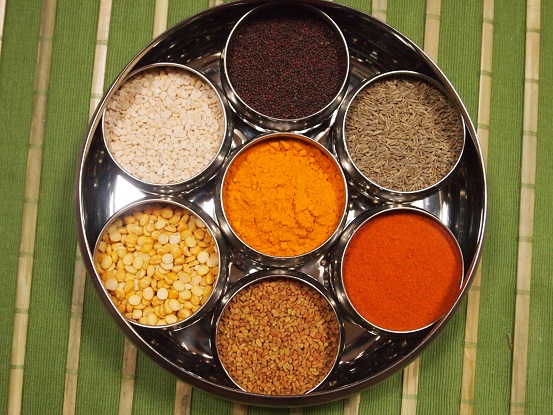
There are many, many dishes in the Indian culinary pantheon that boast ingredient lists a mile long. But there are an equal number, if not more, that require fewer than ten. It’s the type of ingredient that governs the explosion of flavors, not the number.
Most ingredients that you’ll need for these recipes are available at your local grocery store: vegetables, garlic, ginger, green chilies, cilantro, rice, yogurt, naan, and some spices such as black pepper, cardamom and cumin, and even a few lentils such as moong.
Get less widely available ingredients — curry leaves, tamarind fruit and paste, jaggery, certain spices (fenugreek seeds, for example) or spice blends — at the nearest desi grocery store. For your convenience, this recipe roundup includes shopping lists of the ingredients that are mostly only available in desi grocery stores. There’s considerable overlap in ingredients, if making more than one dish from this menu.
Appetizers: Ridge Gourd Chutney and Eggplant Bhartha
Two popular vegetarian South Indian condiments — chutney and bhartha — make for delicious, flavorful dips. Serve with toasted pitas cut into nacho-size pieces.
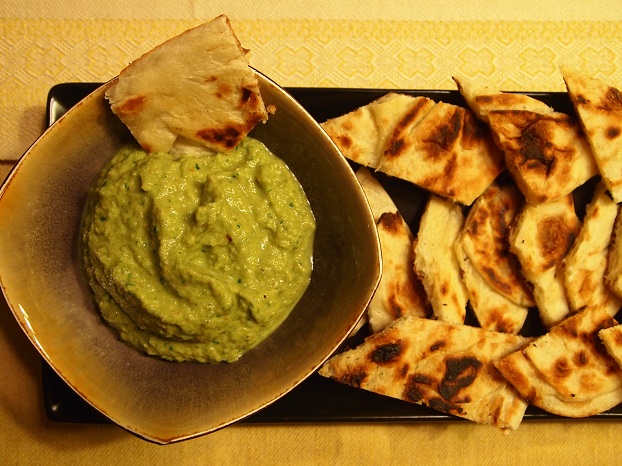
Get the recipes here: Dips With a Twist: New Recipes For an Old Party Standby
In my quest for dips that are a delicious departure from the ordinary, I decided to re-purpose a couple of types of condiments that play supporting roles in South Indian cooking — chutneys and bharthas. Bharthas are somewhat of an unknown quantity outside of desi circles, and while various types of chutneys are popular items on grocery store shelves, the many different South Indian cuisines boast of so many varieties that are still only found in home cooking.
Desi grocery store shopping list:
Eggplant Bhartha: Dried chilies, sesame seeds (for sesame seed powder); for tempering (which is optional), you will need: mustard seeds, asafetida, curry leaves.
Ridge Gourd Chutney: Ridge gourd, fenugreek seeds or fenugreek powder, tamarind, jaggery.
Main Course: Dal, Raita, Curry and Pickle, Served with Steamed Rice or Chapatti
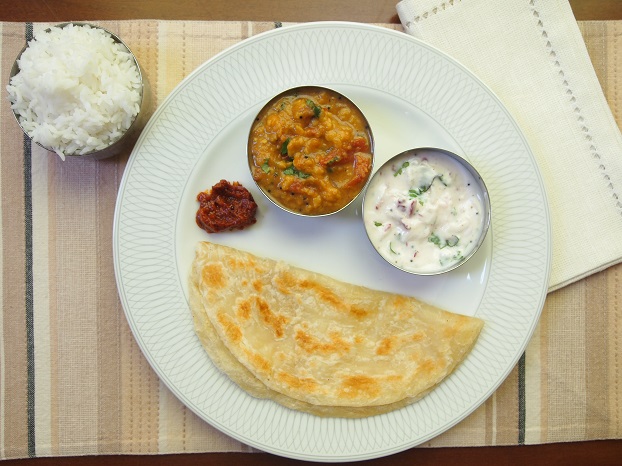
Get the Tomato Dal and Raita Recipes here: Tamarind – A Fruit Doubles as Spice
The following recipe for Tomato Dal is from my mom-in-law’s family, for a dish that already gets some of its sourness from tomatoes, but showcases the tamarind’s unique brand of sourness which enhances the flavor tremendously…. I’ve also included a recipe for Baby Radish Raita, which complements the Tomato Dal perfectly. Here I’ve used baby radish, which is softer and much less pungent than the long white radish usually found in this raita.
South Indian vegetarian meals usually end with a yogurt dish, such as yogurt rice or a glass of buttermilk. Cold buttermilk or yogurt is an admirable and refreshing counterpoint to the hot, spicy dishes that have formed the bulk of the meal. Here, the Raita performs the same duty. You could use peeled, seeded and chopped cucumber or peeled and grated carrots in place of the baby radish.
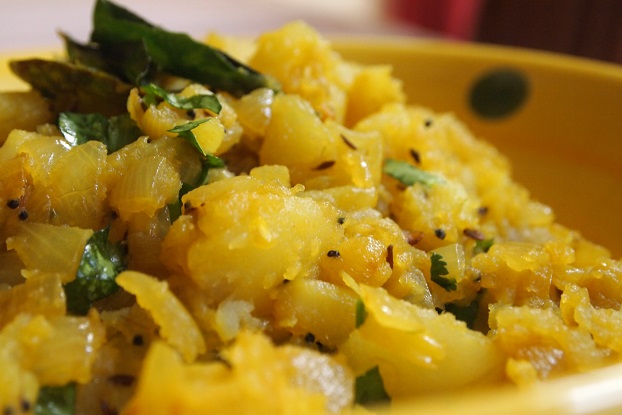
Get the Potato & Onion Curry Recipe Here: Essential Spices + Potato and Onion Curry
If you are going to be serving the curry to children or someone who’s not used to spicy foods, remove the green chilies and curry leaves from the finished curry and discard them.
Potato curry is a staple in nearly all the various cuisines of India. You could substitute peeled and diced carrots, diced fresh beans or chopped cabbage for the potatoes. You could also combine the carrots and beans or the carrots and cabbage.
Pickles To The Rescue
Pickles are a treasured condiment in Indian cuisine. Tart vegetables or unripe fruits (such as mango) combine with copious amounts of salt, chili powder, mustard seeds or their powder, fenugreek seed powder and oil to produce flavors that explode on your tongue.
Pickles are served alongside rice and breads to complement curries and dals, to provide that extra kick of saltiness, spiciness and bitterness. Pickles also swoop in to save the day when you haven’t cooked anything and all you have is some leftover rice or chapattis. Rice and pickle or chapatti and pickle are classic combinations on their own. A teaspoon of pickle is all it takes to spice up a whole bowl of rice.
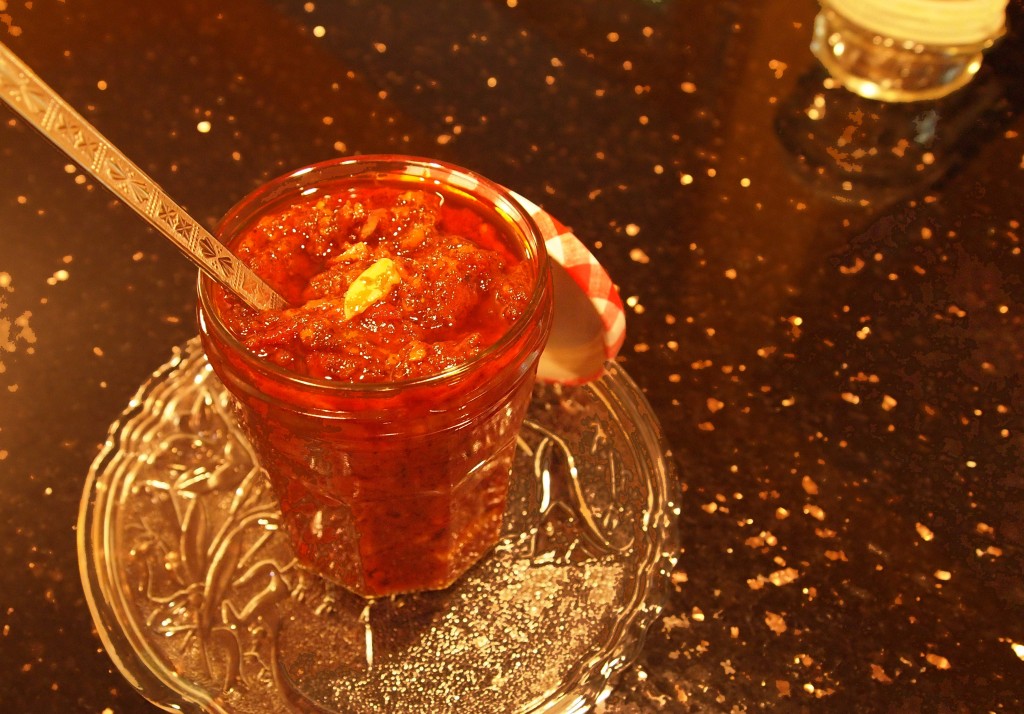
Get the Tomato Pickle Recipe Here: ‘Food is the Tie That Binds’
Pickling is usually a process that takes days if not weeks, but in less than a couple of hours, you could have on your hands this tomato pickle designed to delight your taste buds and impress your guests.
For an even quicker recipe for an Indian pickle, my go-to dish is the Cranberry Pickle. And what better way to marry the Indian method to a Thanksgiving staple? This recipe is from my friend, Lakshmi, and ever since she shared it with me I’ve made it once a year, at least.
Both these pickles can be made a couple of days ahead so you have less to do on the day of your holiday feast. Make sure to refrigerate them in dry jars.
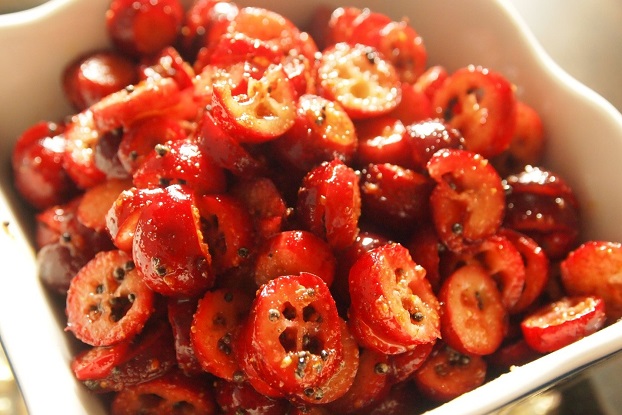
Cranberry Pickle Recipe
You will need firm, undamaged cranberries. Clean, chop off any dry ends near the stems, wash thoroughly and dry them completely. Even trace amounts of water will rot the berries. Chop the berries into halves or into thick slices. You will need about two cups of chopped cranberries.
Add salt (about 2 tsps) and red chili powder (about 1 tsp) to taste. That might seem like a lot of salt and chili powder, but remember you need heavy ammunition to counter the cranberries’ sourness. Start with smaller amounts, however. The pickle is all about feeling the pop of each of the flavors in your mouth, but at the end of the day you must also enjoy eating it.
Add a dash of turmeric powder and roasted fenugreek powder (1tsp). In a small sauce pan, heat (untoasted) sesame seed oil (a little less than ¼ cup), add a dash of asafetida and mustard seeds (1tsp). Wait for the oil mixture to cool and add to the cranberry mix. Mix gently but thoroughly.
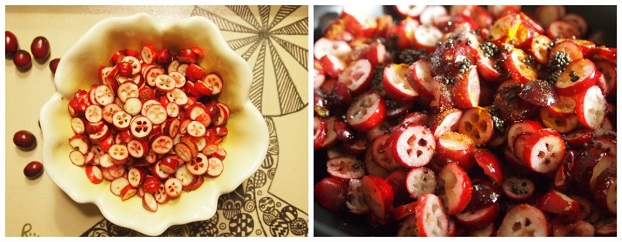
You could put out a small bowlful of the cranberry pickle along with the dips. One sliced piece of pickled cranberry goodness will go well with hummus, chutney or bhartha.
Serve the Tomato Dal, the Raita and the Potato and Onion Curry with steamed rice, roasted chapattis (available at your nearest desi grocery store) or with pita or other Middle Eastern breads.
Desi grocery store shopping list:
Tomato Dal – Toor dal, mustard seeds, asafetida, turmeric powder, curry leaves, tamarind, fenugreek seeds or fenugreek powder, chili powder.
Raita – Mustard seeds, dried red chilies, asafetida, curry leaves.
Potato and Onion Curry – Mustard seeds, cumin seeds, turmeric powder, curry leaves, grated unsweetened coconut.
Tomato Pickle – Tamarind, fenugreek seeds or fenugreek powder, mustard seeds, jaggery, chili powder.
Cranberry Pickle – Chili powder, turmeric powder, fenugreek seeds or fenugreek powder, sesame seed oil, asafetida, and mustard seeds.
Dessert: Cracked Wheat Payasa
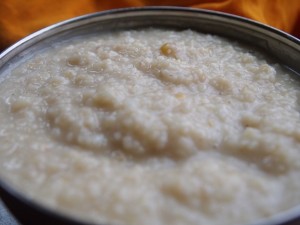 Cracked Wheat Payasa is a nutritious breakfast food masquerading as dessert but there’s really no need to tell anyone that. The source of the sweetness here is jaggery which is boiled, concentrated and solidified sugar cane syrup (unlike sugar, jaggery retains the molasses along with the sugar crystals and more of the minerals found in sugar cane). This recipe makes about twelve servings. Adjust proportions as necessary if you need to lower or raise the number of servings.
Cracked Wheat Payasa is a nutritious breakfast food masquerading as dessert but there’s really no need to tell anyone that. The source of the sweetness here is jaggery which is boiled, concentrated and solidified sugar cane syrup (unlike sugar, jaggery retains the molasses along with the sugar crystals and more of the minerals found in sugar cane). This recipe makes about twelve servings. Adjust proportions as necessary if you need to lower or raise the number of servings.
Ingredients:
1 cup cracked wheat (see tip below)
6 cups water
1 tsp rice
1 tsp channa dal (split chickpeas)
1 to 1 ½ cups grated jaggery
1 tsp poppy seeds
2 tbsp dry grated coconut
1 cup whole milk
4 cardamoms, peeled and powdered
Method:
Rinse the cracked wheat, rice and channa dal in some cold water until the water runs clear, taking care not to lose any of the cracked wheat. Transfer to a heavy sauce pan and add the 6 cups of water. Bring to a boil on a high flame, lower the heat, cover with a tight-fitting lid and let cook for about 30 to 45 minutes, stirring occasionally. When the wheat has absorbed nearly all of the water and gives easily when smushed with your fingers, turn off the flame, add the jaggery and mix thoroughly. Start with one cup, stir and add a little more to your taste. Cook on a medium flame for about 5 minutes stirring frequently until the jaggery is dissolved completely. Add milk, cardamom powder, poppy seeds and grated coconut, mix well and cook for about 2 minutes longer. Transfer a serving bowl.
Serve warm or cold.
Tip:
If the cracked wheat has a musty smell, winnow it on a plate to separate flakes and other small debris, discard the debris and roast the wheat in a heavy bottomed pan in a few drops of oil. Take care not to burn the wheat. Keep the flame on low once you add the wheat and stir frequently. Roast just until the wheat smells nice and fresh. Let cool. Skip the rinsing step.
Desi grocery store shopping list:
Cracked wheat, chana dal, jaggery, dry grated coconut, cardamom.
Vegan and Gluten Information:
Please review the nutrition information in all the packaging. Other than the Raita and the Payasa, all the recipes are vegan. The chapattis and the Payasa contain gluten in the main ingredients. Most of the rest of the recipes contain gluten in the form of asafetida. If you want to make any of the other recipes gluten-free, do not add asafetida in any recipe that calls for it. Asafetida contains small amounts of wheat flour to make it flow easily from the box.
* * *
All photos in this post courtesy of the writer. Sujatha Bagal is a Washington, D.C.- based freelance writer and blogger. Her essays, articles and stories have appeared in various online and print publications, including Pregnancy, Mint Lounge, ForbesLife India and The Smart Set (links available here). She is currently working with her mom-in-law on a cookbook featuring regional Karnataka cuisine. Find her on Twitter and Instagram.












